
myCBSEguide App
Download the app to get CBSE Sample Papers 2023-24, NCERT Solutions (Revised), Most Important Questions, Previous Year Question Bank, Mock Tests, and Detailed Notes.
Install NowCBSE Class 12 Physics Chapter 10 Wave Optics notes in PDF are available for free download in myCBSEguide mobile app. The best app for CBSE students now provides Wave Optics class 12 Notes latest chapter wise notes for quick preparation of CBSE board exams and school-based annual examinations. Class 12 Physics notes on chapter 10 Wave Optics are also available for download in CBSE Guide website.
CBSE Guide Wave Optics class 12 Notes
CBSE guide notes are the comprehensive notes which covers the latest syllabus of CBSE and NCERT. It includes all the topics given in NCERT class 12 Physics textbook. Users can download CBSE guide quick revision notes from myCBSEguide mobile app and my CBSE guide website.
Class 12 Physics notes Chapter 10 Wave Optics
Download CBSE class 12th revision notes for chapter 10 Wave Optics in PDF format for free. Download revision notes for Wave Optics class 12 Notes and score high in exams. These are the Wave Optics class 12 Notes prepared by team of expert teachers. The revision notes help you revise the whole chapter 10 in minutes. Revision notes in exam days is one of the best tips recommended by teachers during exam days.
Download Revision Notes as PDF
CBSE Class 12 Physics Revision Notes Chapter 10 Wave Optics
- Wavefront: It is the continuous locus of all such particles of the medium which are vibrating in the same phase of oscillation at any instant.
Depending upon the shape of the source of light, wavefront are of different shapes.
(i) Plane wavefront
(ii) Spherical wavefront
(iii) Cylindrical wavefront
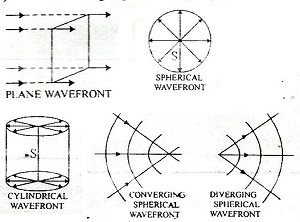
- Rays: Rays are the arrows perpendicular to the wavefront in the direction of propagation of a wave.
- Time Taken: The time taken for light to travel from one wavefront to another is called time taken by a ray.
- Huygens’ Principle:
- According to Huygens’ Each point on the given wave front (called primary wave front) acts as a fresh source of new disturbance, called secondary wavelet, which travels in all directions with the velocity of light in the given medium.
- A surface touching these secondary wavelets, tangentially in the forward direction at any instant gives the new wavefront at that instant. This is called secondary wavelets.
- Principle of Huygens’ Construction:
- It is based on the principle that every point on a wavefront is a source of secondary wavefront.
- The envelope of these wavefronts i.e., the surface tangent to all the secondary wavefront gives the new wavefront.
- Snell’s law of refraction:
- Reflection of Plane Waves Using Huygens’ Principle: The law of reflection (i = r) can be derived using the wave theory.
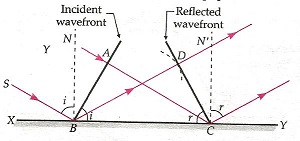
Refraction of Plane Waves Using Huygens’ Principle: the Snell’s law of refraction can be derived using the wave theory. (Here v1 and v2 are the speed of light in media 1 and 2 with refractive index and respectively).
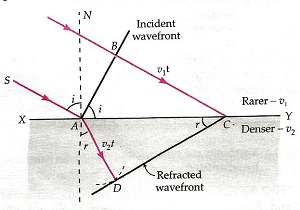
- Relation between Frequency and Speed: The frequency remains the same as light travels from one medium to another. The speed v of a wave is given by
Where is the wavelength of the wave and is the period of oscillation.
- Doppler Effect: Whenever there is a relative motion between the source and observer then the apparent frequency of ligt received by the observer is different from the actual frequency emitted by the source of light. This effect is called Doppler’s effect in light. The effect can be used to measure the speed of an approaching or receding object.
- Change in Frequency: For the source moving away from the observer , and for the source moving towards the observer , . The change in frequency is
So, finally,
- Coherent and Incoherent Addition of Waves:
Coherent sources:- Two sources of light which continously emit light waves of same frequency (or wavelength) with a zero or constant phase difference between them, are called coherent sources.
Incoherent sources:- Two sources of light which do not emit light waves with a constant phase difference are called incoherent sources.
The total intensity I is not just the sum of individual intensities I1 and I2 due to the two sources but includes an interference term-
The interference term averaged over many cycles is zero if
- The sources have different frequencies or
- The sources have the same frequency but no stable phase difference.
- For such coherent sources-
- According to the superposition principle when two or more wave motions traveling through a medium superimpose one another, a new wave is formed in which resultant displacements due to the individual waves at that instant is given by-
- The average of the total intensity will beWhere is the inherent phase difference between the two superimposing waves.
- The significance is that the intensity due to two sources of light is not equal to the sum of intensities due to each of them.
- The resultant intensity depends on the relative location of the point from the two sources, since changing it changes the path difference as we go from one point to another.
- As a result, the resulting intensity will vary between maximum and minimum values, determined by the maximum and minimum values of the cosine function. These will be = =
- Young’s Experiment
Two parallel and very close slits S1 and S2 (illuminated by another narrow slit) behave like two coherent sources and produce a pattern of dark and bright bands on a screen known as interference fringes.
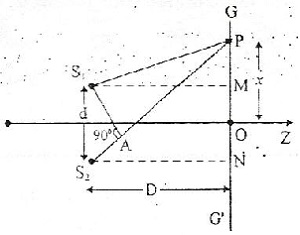
For a point P on the screen, the path difference
Where d is the separation between two slits, D is the distance between the slits and the screen and x is the distance of the point of P from the central fringe.
For constructive interference (bright band), the path difference must be an integer multiple of , i.e.-The separation between adjacent bright (or dark) fringes is, using which can be measured. - Young’s Double Slit Interference Experiment: Fringe width,
where D is the distance between the slits & the screen d is the distance between the two slits - Constructive Interference:
- Phase difference : where n is an integer
- Path difference: where n is an integer
- Destructive interference:
- Phase difference : , where n is an integer
- Path difference: , where n is an integer
- Intensity distribution curve for interference:
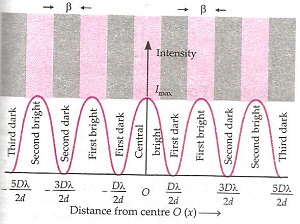
- Interference fringes with white light:- When the slits are illuminated with white light, the interference pattern consist of a central white fringe having on both sides a few coloured fringes and then a general illumination.
Conditions for sustained interference:-
(i) Two sources of light must be coherent.
(ii) The frequencies (or wavelength) of the two waves should be equal.
(iii) The light must be monochromatic.
(iv) The amplitudes of the interfering waves must be equal or nearly equal.
(v) The two sources must be narrow. - Diffraction:
- The phenomenon of bending of light around the corners of an obstacle is called the diffraction of light.
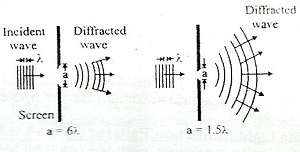
- Diffraction due to Single Slit:
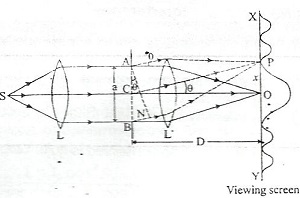
- The single-slit diffraction pattern shows the central maximum , zero intensity at angular separation
- Angular spread of the central maxima
- Width of the central maxima:
Where D is the distance of the slit from the screen, d is the slit width.
- Condition for the Minima on the either side of the Central Maxima: , where n = 1,2,3,….
- Relation between phase difference & path difference:
Where is the phase difference & is the path difference. - Different Parts of the WaveFront at the Slit act as Secondary Sources:
- Diffraction pattern is the result of interference of waves from these sources.
- The intensity plot looks as follows, with there being a bright central maximum, followed by smaller intensity secondary maxima, with there being points of zero intensity in between, whenever
- Width of central maximum is directly proportional to wavelength of light and inversely proportional to the width of the slit.
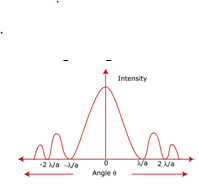
- Emission, Absorption and Scattering:
- These are the three processes by which matter interacts with radiation. In emission, an accelerated charge radiates and loses energy.
- In absorption, the charge gains energy at the expense of the electromagnetic wave.
- In scattering, the charge accelerated by incident electromagnetic wave radiates in all direction.
- Polarization:
- If the vibrations of a wave are present in just one direction in a plane perpendicular to the direction of propagation, the wave is said to be polarised or plane polarised. the phenomenon of restricting the oscillations of a wave to just one direction in the transverse plane is called polarisation of waves.
- When light passes through a single polaroid P1 light intensity is reduced to half, independent of the orientation of P1. When a second Polaroid P2 is also included, at one specific orientation w.r.t P1, the net transmitted intensity is reduced to zero but is transmitted fully when P1 is turned 900 from that orientation. This happens because the transmitted polarization by a polaroid is the component of E parallel to its axis.
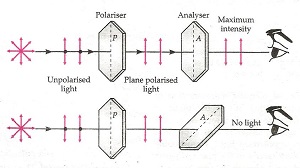
- Polariser: A device that polarises the unpolarised light passed through it is called a polariser.
- Unpolarized sunlight scattered by the atmosphere or reflected from a medium gets partially polarized.
- Optical Activity: When plane polarised light passes through a certain substances, the plane of polarisation of the light is rotated about the direction of propagation of light through a certain angle. This phenomenon is called optical activity or optical rotation and the substances optically active.
- Intensity of the Light due to Polarization (Law of Malus):
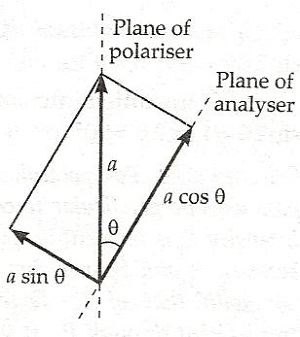
Where I is the intensity of light after polarization, Io is the original intensity, is the angle between the axis of the analyzer & the polarizer
A graph between the intensity of light I transmitted by the analyser and the angle between the polariser and the analyser will be as shown-
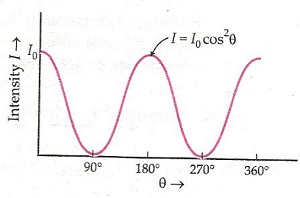
Methods of producing plane polarised light:
- Reflection
- Scattering
- Double refraction
- Polarisation by reflection (Brewster’s Law): When unpolarised light is incident on a transparent surface at the polarising angle , the reflected light is polarised with its electric vector perpendicular to the plane of incidence when the refracted and reflected rays make a right angle with each other.
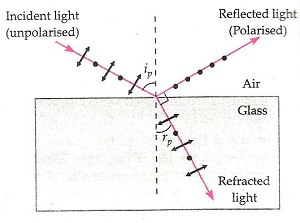
- Polarization by Scattering:
- Light is scattered when it meets a particle of similar size to its own wavelength. The scattering of sunlight by dust particles is an example of polarization by scattering.
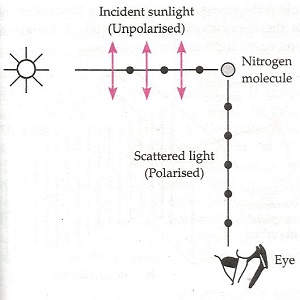
- Polarization by double refraction: When an unpolrised ray passes through certain crystals like quartz or calcite, it spilts up into two rays. This phenomenon is called double refraction.
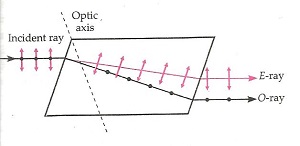
Rayleigh showed that the scattering of light is proportional to the fourth power of the frequency of the light or varies as where is the wavelength of light incident on the air molecules of size ‘d’ where . Hence blue light is scattered more than red. This explains the blue colour of the sky. - Polaroids: Polaroids are thin commercial sheets which make use of the property of selective absorption to produce an intense beam of plane polarised light.
- Uses of polaroids- In sunglasses and camera filters, In wind screens, In window panes of aeroplanes, In LCDs etc.
CBSE Class 12 Revision Notes and Key Points
Wave Optics class 12 Notes. CBSE quick revision note for class 12 Physics, Chemistry, Math’s, Biology and other subject are very helpful to revise the whole syllabus during exam days. The revision notes covers all important formulas and concepts given in the chapter. Even if you wish to have an overview of a chapter, quick revision notes are here to do if for you. These notes will certainly save your time during stressful exam days.
- Physics
- Chemistry
- Mathematics
- Biology
- Accountancy
- Economics
- Business Studies
- Computer Science
- Informatics Practices
- English Core
- History
- Physical Education
To download Wave Optics class 12 Notes, sample paper for class 12 Physics, Chemistry, Biology, History, Political Science, Economics, Geography, Computer Science, Home Science, Accountancy, Business Studies and Home Science; do check myCBSEguide app or website. myCBSEguide provides sample papers with solution, test papers for chapter-wise practice, NCERT solutions, NCERT Exemplar solutions, quick revision notes for ready reference, CBSE guess papers and CBSE important question papers. Sample Paper all are made available through the best app for CBSE students and myCBSEguide website.
- Electric Charges and Fields class 12 Notes Physics
- Electrostatic Potential and Capacitance class 12 Notes Physics
- Current Electricity class 12 Notes Physics
- Moving Charges and Magnetism class 12 Notes Physics
- Magnetism and Matter class 12 Notes Physics
- Electromagnetic Induction class 12 Notes Physics
- Alternating Current class 12 Notes Physics
- Electromagnetic Waves class 12 Notes Physics
- Ray Optics and Optical class 12 Notes Physics
- Dual Nature of Radiation and Matter class 12 Notes Physics
- Atoms class 12 Notes Physics
- Nuclei class 12 Notes Physics
- Electronic Devices class 12 Notes Physics
- Communication Systems class 12 Notes Physics

Test Generator
Create question paper PDF and online tests with your own name & logo in minutes.
Create Now
myCBSEguide
Question Bank, Mock Tests, Exam Papers, NCERT Solutions, Sample Papers, Notes
Install Now